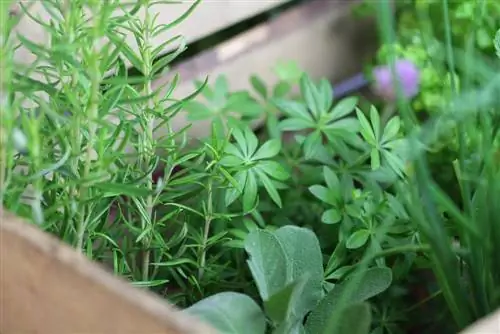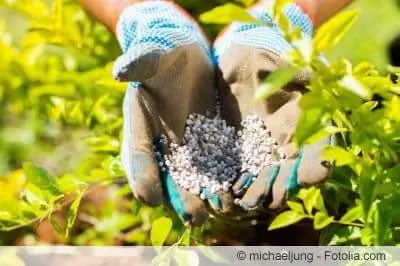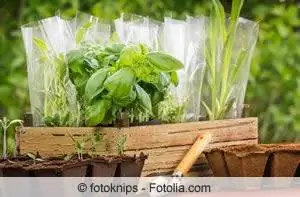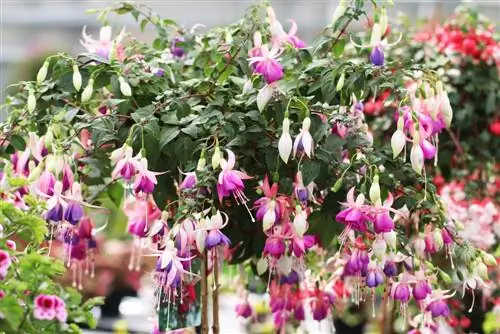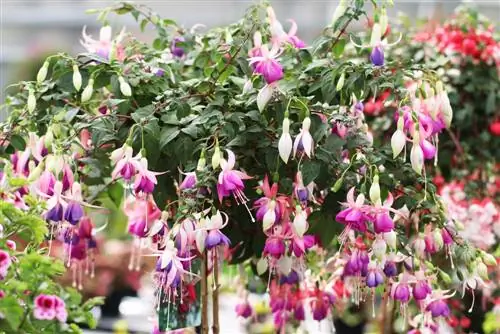- Author admin [email protected].
- Public 2023-12-17 03:39.
- Last modified 2025-01-24 12:45.
Watering and fertilizing is actually quite simple if everything is done correctly when assembling the plants in each container. Not all herbs go together. Some herbs require very little water, others require significantly more. It's similar with nutrients. The immediate neighborhood must also be taken into account. Not every herb can work with the other. So if you know the needs of the individual herbs and place them accordingly, watering and fertilizing can be done very easily.
Correct combination of herbs
The selection of plants to be planted in a common container, such as a balcony box, is crucial to their prosperity. Of course, the lighting conditions on site and the plant substrate also play a role.
Tip:
It is better to plant only annual herbs together or only biennial or perennial ones.
Annual herbs include: basil, dill, garden cress, chamomile, chervil, coriander, marjoram, parsley, rosemary and stevia. Most of them are simply not hardy and are therefore considered annuals, even though they are actually perennials. The biennial and perennial herbs include: mugwort, winter savory, blood sorrel, watercress, tarragon, caraway, garlic, mint, lemon balm, oregano, common sage, chives, celery and common thyme.
For example, dill, garden cress, marjoram, parsley, borage and chervil are suitable for a larger balcony box. These annual herbs like equal site conditions and can be planted in a uniform substrate. The soil should not be too dry, but it should not stay wet for too long either. They also like similar conditions when it comes to fertilizer. Everything fits together here.
For example, oregano, sage and savory are suitable for a smaller balcony cat. These three need a lot of sun, can also cope with drought and need fewer nutrients, so the combination is great. Chives, thyme, sage, lemon balm and tarragon also harmonize.
Under no circumstances should basil and lemon balm be planted together, nor should thyme and marjoram, fennel and coriander, dill and tarragon or very strong growing herbs such as lavender or lovage. Larger growing herbs like to stand alone. They are simply too big for normal balcony boxes on the parapet. They are planted in separate, larger containers and placed directly on the floor of the balcony. These include the lavender and lovage just mentioned, the laurel, wormwood, lemongrass, hyssop, the boar's rue and the clove tree.
Planting substrate
Almost all herbs need well-drained soil. It is ideal to install a drainage system at the bottom of the vessel so that excess water can drain away. Expanded clay is well suited for this. There is nothing worse than standing water in containers; this usually leads to the roots rotting very quickly. Heavy loamy or clayey soils are unsuitable for herbs. If there is no other option, make the soil more permeable with coarse sand or fine gravel. For herbs such as lavender, rosemary and the like that come from the Mediterranean region, the soil must be very permeable and not too rich in nutrients. A substrate that is too rich can be emaciated with sand. Lavender likes calcareous soil, so you can mix in some magnesium lime every two years. For the vessels, it is also sufficient to add bird sand, which contains small pieces of lime. For mint, lovage or tarragon, adding plenty of compost is recommended. It is ideal to cover the ground with a layer of mulch, as this retains the moisture a little longer and the soil does not dry out as much. This is not recommended for Mediterranean herbs.
Watering herbs properly
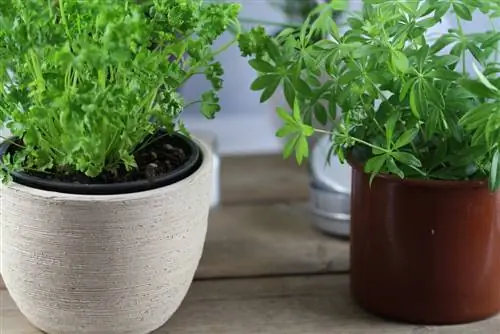
Once you have made the right selection of plants and put them together, watering them is not a problem as long as you don't drown them. Unfortunately, many plant lovers make this mistake; they simply mean too well when it comes to watering. They simply drown their plants. If you don't have the feeling to simply feel or see when it's time to water, you should do the so-called finger test. To do this, simply insert a finger, usually the index finger, about 5 cm deep into the soil. You can feel how moist or dry the substrate is. This way you know when it's time to water, assuming the plants' wishes are known.
Tip:
Tests have shown that the correct amount of watering is about 10 percent of the pot's volume, daily. Herbs also benefit from being watered moderately on a regular basis rather than just every few days and then a lot.
- It is best to use stale water for watering. This is also the right temperature. Freshly tapped tap water should never be too cold.
- Rainwater is ideal, but most herbs can also tolerate our tap water.
- Very calcareous water is not suitable for many species.
- Do not water in the blazing midday sun. Morning is much better, evening is also recommended, although on cold nights care must be taken that the leaves do not get wet, otherwise disease will be promoted.
- Thyme, marjoram, oregano and rosemary only require a little water.
- Malissa, lovage, chives, chervil and parsley need a little more.
- Tarragon and basil need to be watered a lot
Fertilize herbs properly
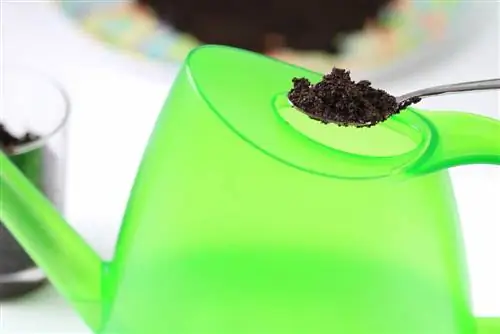
Many herbs are very frugal plants that don't need a lot of nutrients. But there are also those that need plenty of replenishment in order to develop properly and develop their aromatic substances. Since the naturally occurring nutrients are missing in containers, fertilization is necessary. There are special herbal fertilizers available commercially. The problem with these, however, is that the herbs have different requirements. Therefore, a single fertilizer is unfavorable for everyone. When dosing the fertilizer, it is important that only plants grow in a container that match each other in terms of their nutritional requirements. Otherwise, there is a great risk of over-fertilization and the plants can even die as a result. The herbal fertilizers from the market are only suitable for plants in containers, not for outdoor use and only for herbs that need plenty of nutrients. The dosage must be strictly adhered to, as well as the recommendations for the intervals between fertilizations. If you have planted your herbs in fresh herb soil, you don't have to fertilize them for the first 6 to 8 weeks because this substrate already contains long-term fertilizer. Premature fertilization leads to over-fertilization.
- The best fertilizer for herbs is compost, at least for those that only have medium nutrient requirements, such as chervil, tarragon and lovage.
- In any case, organic fertilizer should be used because the herbs are intended to be used. Organic fertilizer is also good for soil organisms, which in turn improve the soil. Nettle broth, horn shavings or horn meal, rock dust and others are well suited.
- Coffee grounds are a good fertilizer for some herbs. Not only does it release nutrients (only a few, so for weak eaters), it also keeps pests away, especially snails that don't crawl over it. Coffee grounds are not suitable for lime-loving herbs, such as sage, oregano or borage.
- Herbs with high nutritional requirements: wild garlic, basil, tarragon, lovage, mint, chives, lemon verbena
- Herbs with medium nutritional requirements: borage, dill, chervil, oregano, sage, hyssop, lemon balm
- Herbs with low nutritional requirements: mugwort, savory, cress, lavender, marjoram, rosemary, thyme, rue
Conclusion
Watering and fertilizing herbs properly is not a science, but there are some basic things to consider. It is absolutely important to only put herbs together in a container that have the same requirements in terms of location, soil, water and nutrients. That is not always easy. Sometimes it is better to use several small containers and place them next to each other in a balcony box rather than planting them directly together. An alternative are planters with an irrigation system, which have two smaller inserts in a long box. This way you can put two different groups together. You just have to know how to help yourself. To test when it is time to water again, simply stick a finger into the substrate. That reveals a lot. Too much watering is significantly worse for most herbs than too little, although not for all. Herbs that don't get enough water don't die straight away. They show by limp leaves that it is time to water. They usually recover quickly. Constantly wet soil is not so noticeable. The roots are rotting away. If there is damage to the plant, there is usually nothing that can be saved because there is not much that can be done to prevent rot.

